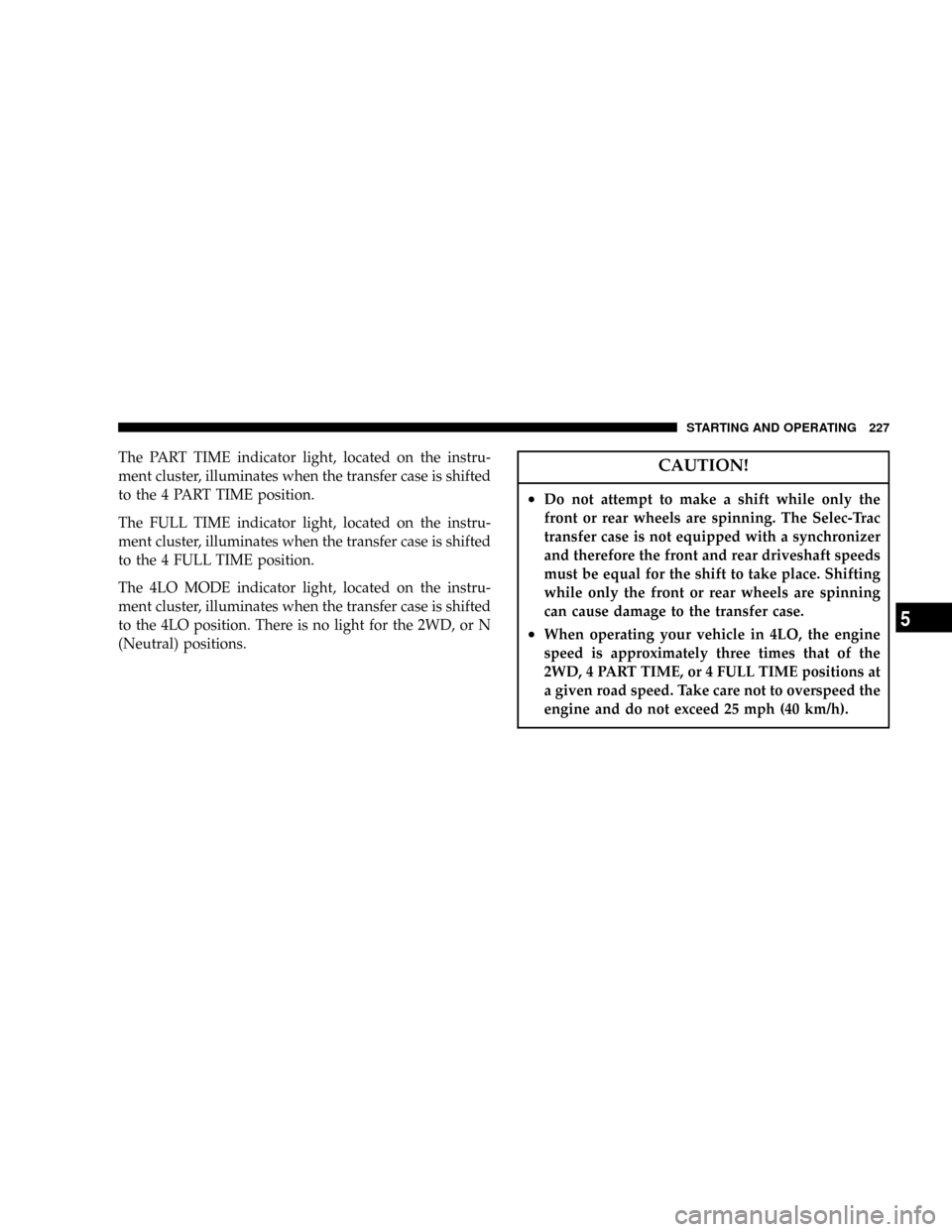JEEP LIBERTY 2004 KJ / 1.G Owners Manual
Manufacturer: JEEP, Model Year: 2004, Model line: LIBERTY, Model: JEEP LIBERTY 2004 KJ / 1.GPages: 374, PDF Size: 5.71 MB
Page 221 of 374

Over Temperature Mode
The transmission electronics constantly monitor the
transmission oil temperature. If the transmission gets too
hot, the transmission will change the way it shifts to help
control the condition. This may result in a slightly
different feeling or response during normal operation in
D (Drive) position. If the transmission becomes hot
enough the TRANS TEMP warning light in the instru-
ment cluster will come on. After the transmission cools
down, it will return to normal operation.
Torque Converter Clutch
A feature designed to improve fuel economy has been
added to the automatic transmission of this vehicle. A
clutch within the torque converter engages automatically
at calibrated speeds. This may result in a slightly differ-
ent feeling or response during normal operation in high
gear. When the vehicle speed drops or during accelera-
tion, the clutch automatically and smoothly disengages.NOTE:
²The torque converter clutch will not engage until the
transmission fluid and engine coolant is warm (usu-
ally after 1±3 miles (1.6±4.8 km) of driving). Because
engine speed is higher when the torque converter
clutch is not engaged, it may seem as if the transmis-
sion is not shifting into ªOverdriveº when cold. This is
considered a normal condition. Pressing the ªO/D
OFFº switch will show that the transmission is able to
shift into and out of ªOverdrive.º
²If the vehicle has not been driven for several days, the
first few seconds of operation after shifting the trans-
mission into gear may seem sluggish. This is due to the
transmission fluid partially draining from the torque
converter into the transmission. This is considered a
normal condition and will not cause damage to the
transmission. The torque converter will refill within 5
seconds of shifting from P (Park) into any other gear
position.
STARTING AND OPERATING 221
5
Page 222 of 374

FOUR-WHEEL DRIVE OPERATION
Command-TracTOperating
Information/Precautions
The Command-Tracttransfer case provides 4 mode
positions-2(rear) wheel drive high range, 4-wheel drive
high range, neutral, and 4-wheel drive low range.
This transfer case is intended to be driven in the 2-wheel
drive position (2H) for normal street and highway con-
ditions such as dry hard surfaced roads.
When additional traction is required the transfer case 4H
and 4L positions can be used to lock the front and rear
driveshafts together and force the front and rear wheels
to rotate at the same speed. This is accomplished by
simply moving the shift lever to these positions. The 4H
and 4L positions are intended for loose, slippery road
surfaces only. Driving in the 4H and 4L positions on dry
hard surfaced roads may cause increased tire wear and
damage to the driveline components.The PART TIME indicator light, located in the instrument
cluster, illuminates when the transfer case is shifted to the
4H position.
The 4 LO MODE indicator light, located in the instru-
ment cluster, illuminates when the transfer case is shifted
to the 4L position. There is no light for the 2H or N
(Neutral) positions.
222 STARTING AND OPERATING
Page 223 of 374

CAUTION!
²Do not attempt to make a shift while only the
front or rear wheels are spinning. The Command-
Trac transfer case is not equipped with a synchro-
nizer and therefore the front and rear driveshaft
speeds must be equal for the shift to take place.
Shifting while only the front or rear wheels are
spinning can cause damage to the transfer case.
²When operating your vehicle in 4L, the engine
speed is approximately three times that of the 2H
or 4H positions at a given road speed. Take care
not to overspeed the engine and do not exceed 25
mph (40 km/h).
Proper operation of 4-wheel drive vehicles depends on
tires of equal size, type and circumference on each wheel.
Any difference will adversely affect shifting and can
cause damage to the transfer case.
STARTING AND OPERATING 223
5
Page 224 of 374

WARNING!
²Because 4-wheel drive provides improved trac-
tion, there is a tendency to exceed safe turning and
stopping speeds. Do not go faster than road con-
ditions permit.
²You or others could be injured if you leave the
vehicle unattended with the transfer case in the
Neutral (N) position without first fully engaging
the parking brake. The transfer case Neutral (N)
position disengages both the front and rear drive-
shafts from the powertrain and will allow the
vehicle to move despite the transmission position.
The parking brake should always be applied
when the driver is not in the vehicle.
Shift Positions
For additional information on the appropriate use of each
transfer case mode position see the information below:
2H
Rear Wheel Drive High Range - Normal street and
highway driving. Dry hard surfaced roads.
4H
4-Wheel-Drive High Range - Locks the front and rear
driveshafts together. Forces the front and rear wheels to
rotate at the same speed. Additional traction for loose,
slippery road surfaces only.
N
Neutral - Disengages both the front and rear driveshafts
from the powertrain. To be used for flat towing behind
another vehicle. Refer to ªRecreational Towingº in Sec-
tion 5 for more information.
224 STARTING AND OPERATING
Page 225 of 374

4L
4-Wheel-Drive Low Range - Low speed 4 wheel drive.
Locks the front and rear driveshafts together. Forces the
front and rear wheels to rotate at the same speed.
Additional traction and maximum pulling power for
loose, slippery road surfaces only. Do not exceed 25 mph
(40 km/h). (Allows engine starting without depressing
the clutch pedal on vehicles equipped with manual
transmission. Refer to ªStarting Procedures Ð Manual
Transmission (4WD Models Only)º in this section.
Shifting Procedure
2H to 4H or 4H to 2H
Shifting between 2H and 4H can be made with the
vehicle in motion up to 55 mph (88 km/h). The transfer
case will engage/disengage faster if you momentarily
release the accelerator pedal after completing the shift.
Apply a constant force when shifting the transfer case
lever.
4H to 4L or 4L to 4H
With the vehicle rolling at 2 to 3 mph (3 to 5 km/h), shift
an automatic transmission to N (Neutral) or depress the
clutch on a manual transmission. While the vehicle is
coasting at 2 to 3 mph (3 to 5 km/h), shift the transfer
case lever firmly to the desired position. Do not pause in
transfer case N (Neutral).
NOTE:To shift from 4H to 4L, the shift lever should
pushed away from the driver, and then rearward into 4L.
In 4H, there is a neutral stop to prevent shifting into N
(Neutral) by accident.
NOTE:Pausing in transfer case N (Neutral) in vehicles
equipped with an automatic transmission may require
shutting the engine OFF to avoid gear clash while
completing the shift. If difficulty occurs, shift automatic
transmission to N (Neutral), hold foot on brake, and turn
engine OFF. Make shift to the desired mode.
STARTING AND OPERATING 225
5
Page 226 of 374

NOTE:Shifting into or out of 4L is possible with the
vehicle completely stopped, however difficulty may oc-
cur due to the mating clutch teeth not being properly
aligned. Several attempts may be required for clutch
teeth alignment and shift completion to occur. The pre-
ferred method is with the vehicle rolling 2 to 3 mph (3 to
5 km/h). Avoid attempting to engage or disengage 4L
with the vehicle moving faster than 2 to 3 mph (3 to 5
km/h).
Selec-TracTOperating Information/Precautions Ð
If Equipped
The Selec-Tracttransfer case provides 5 mode positions -
normal 2-wheel drive mode, part-time 4-wheel drive
high range, full-time 4-wheel drive high range, neutral,
and 4-wheel drive low range.
This transfer case is equipped with an inter-axle differ-
ential which allows driving the vehicle in the 4 FULL
TIME position at all times on any given road surfaceincluding dry hard surfaced roads. The 4 FULL TIME
mode allows the front and rear wheels to rotate at
different speeds which eliminates driveline binding and
component wear that is normally associated with driving
the vehicle in the 4 PART TIME position on dry hard
surfaced roads. This feature provides the safety, security,
and convenience of operating in 4±wheel drive at all
times regardless of road conditions.
When additional traction is required the 4 PART TIME
and 4LO positions can be used to lock the front and rear
driveshafts together through the transfer case inter-axle
differential and force the front and rear driveshafts to
rotate at the same speed. This is accomplished by simply
moving the shift lever to these positions. The 4 PART
TIME and 4LO positions are intended for loose, slippery
road surfaces only. Driving in the 4 PART TIME and 4LO
positions on dry hard surfaced roads may cause in-
creased tire wear and damage to driveline components.
226 STARTING AND OPERATING
Page 227 of 374

The PART TIME indicator light, located on the instru-
ment cluster, illuminates when the transfer case is shifted
to the 4 PART TIME position.
The FULL TIME indicator light, located on the instru-
ment cluster, illuminates when the transfer case is shifted
to the 4 FULL TIME position.
The 4LO MODE indicator light, located on the instru-
ment cluster, illuminates when the transfer case is shifted
to the 4LO position. There is no light for the 2WD, or N
(Neutral) positions.CAUTION!
²Do not attempt to make a shift while only the
front or rear wheels are spinning. The Selec-Trac
transfer case is not equipped with a synchronizer
and therefore the front and rear driveshaft speeds
must be equal for the shift to take place. Shifting
while only the front or rear wheels are spinning
can cause damage to the transfer case.
²When operating your vehicle in 4LO, the engine
speed is approximately three times that of the
2WD, 4 PART TIME, or 4 FULL TIME positions at
a given road speed. Take care not to overspeed the
engine and do not exceed 25 mph (40 km/h).
STARTING AND OPERATING 227
5
Page 228 of 374

Proper operation of 4-wheel drive vehicles depends on
tires of equal size, type, and circumference on each
wheel. Any difference will adversely affect shifting and
can cause damage to the transfer case.WARNING!
²Because 4-wheel drive provides improved trac-
tion, there is a tendency to exceed safe turning and
stopping speeds. Do not go faster than road con-
ditions permit.
²You or others could be injured if you leave the
vehicle unattended with the transfer case in the
Neutral (N) position without first fully engaging
the parking brake. The transfer case Neutral (N)
position disengages both the front and rear drive-
shafts from the powertrain and will allow the
vehicle to move regardless of the transmission
position. The parking brake should always be
applied when the driver is not in the vehicle.
228 STARTING AND OPERATING
Page 229 of 374

Shift Positions
For additional information on the appropriate use of each
transfer case mode position see the information below:
2WD
Rear Wheel Drive High Range - Normal street and
highway driving. Dry hard surfaced roads.
4 PART TIME
Part Time 4±Wheel Drive High Range - Locks the transfer
case inter-axle differential. Forces the front and rear
wheels to rotate at the same speed. Additional traction
for loose, slippery road surfaces only.
4 FULL TIME
Full Time 4-Wheel Drive High Range - Employs an
inter-axle differential. This allows front and rear wheels
to rotate at different speeds, on all road surfaces.
N
Neutral - Disengages both the front and rear driveshafts
from the powertrain. To be used for flat towing behind
another vehicle. Refer to ªRecreational Towingº in Sec-
tion 5 for more information.
4LO
Part Time 4±Wheel Drive Low Range - Low speed
4±wheel drive. Locks the transfer case inter-axle differ-
ential. Forces the front and rear wheels to rotate at the
same speed. Additional traction and maximum pulling
power for loose, slippery road surfaces only. Do not
exceed 25 mph (40 km/h).
STARTING AND OPERATING 229
5
Page 230 of 374

Shifting Procedure
2WD to 4 PART TIME or 4 PART TIME to 2WD
Shifting between 2WD and 4 PART TIME can be made
with the vehicle stopped or in motion. If the vehicle is in
motion, shifts can be made up to 55 mph (88 km/h). With
the vehicle in motion two momentary releases of the
accelerator pedal may be required after shifting. This will
induce a torque interrupt and allow full engagement of
the newly selected position. With the vehicle stationary it
may be necessary to shift the automatic transmission
from D (Drive) to R (Reverse) and back to D (Drive) after
shifting. This will allow full engagement of the newly
selected position. Apply a constant force when shifting
the transfer case lever.
4 PART TIME to 4 FULL TIME or 4 FULL TIME to
4 PART TIME
Shifting between 4 PART TIME and 4 FULL TIME can be
made with the vehicle stopped or in motion. If the vehicleis in motion shifts can be made up to 55 mph (88 km/h).
With the vehicle in motion two momentary releases of the
accelerator pedal may be required after shifting. This will
induce a torque interrupt and allow full engagement of
the newly selected position. With the vehicle stationary it
may be necessary to shift the automatic transmission
from D (Drive) to R (Reverse) and back to D (Drive) after
shifting. This will allow full engagement of the newly
selected position. Apply a constant force when shifting
the transfer case lever.
4 FULL TIME to 4 LO or 4 LO to 4 FULL TIME
With the vehicle rolling at 2 to 3 mph (3 to 5 km/h), shift
an automatic transmission to N (Neutral). While the
vehicle is coasting at 2 to 3 mph (3 to 5 km/h), shift the
transfer case lever firmly to the desired position. Do not
pause in transfer case N (Neutral).
NOTE:To shift from 4 FULL TIME to 4LO, the shift
lever should be pushed away from the driver, and then
230 STARTING AND OPERATING